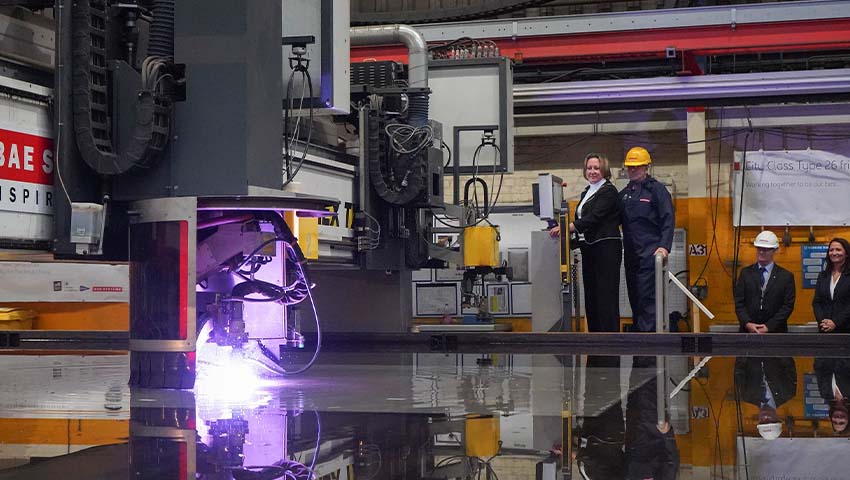In a major milestone for the Royal Navy, BAE Systems has cut steel for the second Type 26 Global Combat Ship, HMS Cardiff, as progress on Australia’s own Hunter Class program continues to gather pace and learn from the experience of the British program.
To continue reading the rest of this article, please log in.
Create free account to get unlimited news articles and more!
In a traditional steel-cutting ceremony at BAE Systems’ shipyard in Govan on the River Clyde, attended by BAE Systems’ employees and representatives from the Royal Navy, Anne-Marie Trevelyan MP, Minister for Defence Procurement, performed the official duties, setting the plasma-cutting machine to work on a plate of steel that will form part of the unit that holds vital fuel stores for the ship.
The Type 26 Global Combat Ship is designed and built by BAE Systems in Glasgow. The Type 26 frigate is an advanced ASW warship designed for the critical protection of the Continuous At Sea Deterrent and Carrier Strike Group.
The City Class Type 26 will build on the pedigree of the Royal Navy’s current Type 23 Anti-Submarine Warfare frigates, which have served the nation well. Each Type 26 will be equipped with a range of capabilities, including the Sea Ceptor missile defence system, a 5-inch medium calibre gun, flexible mission bay, Artisan 997 Medium Range Radar, powerful bow and towed array sonars and a vertical launch silo capable of hosting a variety of weapons.
Minister Trevelyan welcomed the achievement, saying, “The Royal Navy’s new world beating Type 26 anti-submarine frigates are truly a UK-wide enterprise, supporting thousands of jobs here in Scotland and across the UK.
“These ships will clearly contribute to UK and allied security, but also make a strong economic contribution to the country. With 64 subcontracts already placed with UK-based businesses, there will be new export opportunities for them to tender for through the selection of the Type 26 design by Australia and Canada too,” Minister Trevelyan added.
The ceremony to mark the formal start of manufacture on the second of the Type 26 Global Combat Ships, HMS Cardiff, comes two years after steel was cut on the first in class, HMS Glasgow. Momentum on HMS Glasgow continues with over one half of the ship now in production, and she remains on track to enter service in the mid-2020s.
BAE Systems has now marked the start of construction of seven complex warships for the UK Royal Navy in just five years, with HMS Cardiff following her sister ship, HMS Glasgow, and the five River Class Offshore Patrol Vessels (OPV). All five OPVs are now in the water with the first, HMS Forth, already in active operation for the Royal Navy.
Steve Timms, managing director, BAE Systems Naval Ships, added, “Today’s steel cut ceremony demonstrates the significant and positive progress we are making on this hugely complex, sophisticated and important program. The Type 26 ships will be the most advanced anti-submarine warfare frigates the Royal Navy has ever had and, together with the five-ship River Class Offshore Patrol Vessel program, we are proud of the role we play at BAE Systems, alongside many thousands of dedicated people in our supply chain, to deliver this critical capability for the UK Royal Navy.”
These sentiments were shared by Craig Lockhart, managing director, ASC Shipbuilding, who said, “Congratulations to our BAE Systems Naval Ships colleagues in the UK on the cut steel ceremony for HMS Cardiff. This milestone provides assurance and confidence to the Hunter Program stakeholders that our design into manufacture process continues to mature towards a successful prototyping key event next year.
“ASC Shipbuilding is already well progressed in the transfer of technology, skills and know-how from the UK to Australia in readiness to deliver the Royal Australian Navy’s most capable anti-submarine warfare frigate,” Lockhart added.
In June 2018, the Commonwealth government announced BAE Systems Australia as the successful tender for the $35 billion SEA 5000 Future Frigate program.
The nine Hunter Class frigates will be based on the BAE Systems Type 26 Global Combat Ship currently under construction for the Royal Navy and will replace the eight Anzac Class frigates when they enter service beginning in the late 2020s.
The Hunter Class is billed as an anti-submarine warfare (ASW) centric vessel delivering an advanced ASW capability to the Royal Australian Navy at a time when 50 percent of the world’s submarines will be operating in the Indo-Pacific region.
BAE Systems Australia announced that it had selected Lockheed Martin Australia and Saab Australia as combat systems integration industry partners, responsible for delivering the Australian-designed CEAFAR 2 Active Phased Array Radar, Lockheed Martin-designed Aegis combat management system and Saab Australia 9LV tactical interface.
BAE Systems expects the Australian industry content for the Hunter Class build will be 65-70 per cent, which will create and secure thousands of jobs for decades. At the end of the program, the Commonwealth will resume complete ownership of ASC Shipbuilding, thereby ensuring the retention in Australia of intellectual property, a highly skilled workforce and the associated equipment.
SEA 5000 is expected to support over 500 Australian businesses who have been pre-qualified to be part of the Hunter Class supply chain, with the Australian steel industry in particular, benefitting from the 48,000 tonnes of steel required to build the ships

 Login
Login







